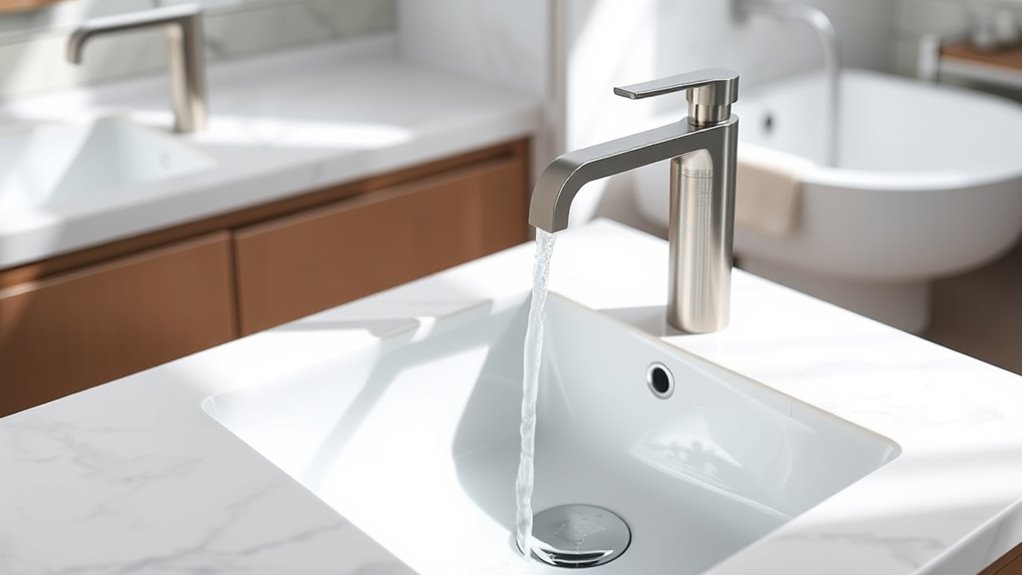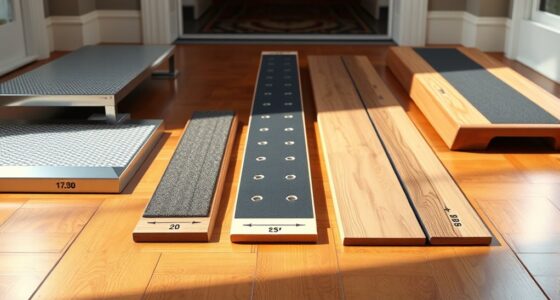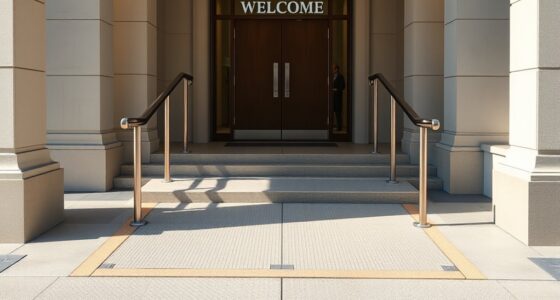Switching to touchless faucets boosts hygiene by eliminating contact points and reducing cross-contamination, making handwashing safer for everyone. They are also great for accessibility, helping those with limited mobility or physical challenges operate sinks easily. Plus, they save water by stopping flow when your hands are away, benefiting the environment and reducing waste. If you want to learn how these faucets can improve your space and support all users, keep exploring more.
Key Takeaways
- Touchless faucets reduce germ spread by eliminating handle contact, promoting better hygiene in homes and public spaces.
- They enhance accessibility for individuals with limited mobility or physical challenges, supporting independent routines.
- Installing touchless faucets is simple, offering long-term benefits like water conservation and improved sanitation.
- They help prevent water waste through automatic shut-off, conserving resources and reducing utility costs.
- Modern designs and customizable features make touchless faucets a stylish, practical upgrade for any environment.

Have you ever wondered how touchless faucets can make your daily routines more hygienic and convenient? The answer lies in innovative sensor technology that allows you to turn water on and off with just a simple gesture. This technology eliminates the need to touch handles, which can harbor germs and bacteria, especially in busy households or public spaces. By reducing contact points, touchless faucets markedly improve overall hygiene, helping prevent the spread of illnesses. Whether you’re washing your hands after gardening or preparing food in the kitchen, you can do so confidently, knowing you’re minimizing cross-contamination.
Touchless faucets improve hygiene by eliminating germ-harboring handles and reducing contact points.
Beyond hygiene, sensor technology also plays a crucial role in water conservation. Traditional faucets often waste water when you forget to turn them off completely or leave them running unintentionally. Touchless faucets, however, instantly stop the flow once you remove your hands from the sensor’s range. This automation ensures you use only the water you need, making a noticeable difference in water bills and environmental impact. In areas where water scarcity is an issue, this simple switch can contribute to substantial resource savings over time. Plus, many models come with adjustable sensor sensitivity and flow rate controls, letting you customize the water usage to suit your needs perfectly.
Switching to touchless faucets isn’t just about hygiene and conservation; it’s about accessibility as well. These faucets are especially beneficial for individuals with limited mobility, arthritis, or other physical challenges that make gripping and turning traditional handles difficult. With sensor-activated operation, anyone can wash their hands or fill containers without struggling with knobs or levers. This ease of use promotes independence and inclusivity, making everyday tasks more manageable for everyone. Furthermore, their sleek, modern design adds a touch of sophistication to any space, whether in your home or commercial setting.
Installing a touchless faucet is straightforward, often requiring only a few adjustments to existing plumbing. Once in place, the sensor technology works seamlessly, providing a hassle-free experience. Over time, the benefits of reduced water waste and improved hygiene become clear, making it a smart investment. As you embrace this technology, you’ll notice how much simpler and cleaner your routines become. It’s a small change that delivers big advantages—saving water, promoting health, and enhancing accessibility—all with the power of sensor technology. Switching to touchless faucets can genuinely transform the way you interact with water, making everyday tasks safer, more efficient, and more eco-friendly.
Adding to their versatility, some models are specifically designed to accommodate tuning Hyundai models for enhanced performance and customization in automotive applications.
Frequently Asked Questions
Are Touchless Faucets Energy-Efficient?
Touchless faucets are generally energy-efficient because they use sensors to control water flow, reducing unnecessary water use and promoting water conservation. While they do require power for their sensors and automatic features, their power consumption is typically low. This means you can enjoy water savings without a significant increase in energy use. Overall, they combine water conservation with minimal power consumption, making them an eco-friendly choice.
Can Touchless Faucets Be Installed Outdoors?
Think of installing a touchless faucet outdoors as planting a sturdy seed. You can absolutely do it, provided you choose models with excellent outdoor durability and weather resistance. These faucets are designed to withstand the elements, resisting rain, sun, and temperature swings. Just make certain you select a unit specifically rated for outdoor use, and you’ll enjoy hands-free convenience and hygiene, no matter the weather storm or sunshine.
Do Touchless Faucets Require Special Plumbing?
You might wonder if touchless faucets need special plumbing. Generally, they’re compatible with standard plumbing, but it’s essential to check your plumbing compatibility before installation. Some models require a power source or specific sensors, which can impact faucet maintenance. If your plumbing setup is conventional, you shouldn’t need major modifications. However, ensuring proper installation helps maintain the faucet’s functionality and longevity, making maintenance easier over time.
How Long Do Batteries Last in Sensor Faucets?
The battery lifespan of sensor faucets varies depending on their power consumption and usage frequency. Typically, you can expect batteries to last between 6 months and 2 years. Higher power consumption faucets tend to drain batteries faster, especially with frequent use. To maximize battery life, consider using energy-efficient models and replacing batteries promptly when you notice reduced sensor performance. Regular maintenance guarantees your touchless faucet remains functional and reliable.
Are Touchless Faucets Suitable for Children?
Touchless faucets can be suitable for children if you prioritize child safety and ease of use. They help prevent cross-contamination and are generally easy for kids to operate since they don’t require turning handles. However, you should make certain the sensor’s sensitivity isn’t too high, so kids don’t accidentally activate it. With proper supervision and adjustable features, touchless faucets can be a safe, convenient choice for children’s bathrooms or kitchens.
Conclusion
Switching to touchless faucets transforms your space, blending hygiene with accessibility effortlessly. While you might think they’re just about convenience, they also promote better health and safety—especially in busy households or public areas. It’s a simple upgrade that offers peace of mind and inclusivity, proving that innovation doesn’t have to sacrifice style or ease. So, as you embrace this modern change, remember: sometimes, the smallest adjustments make the biggest difference.









